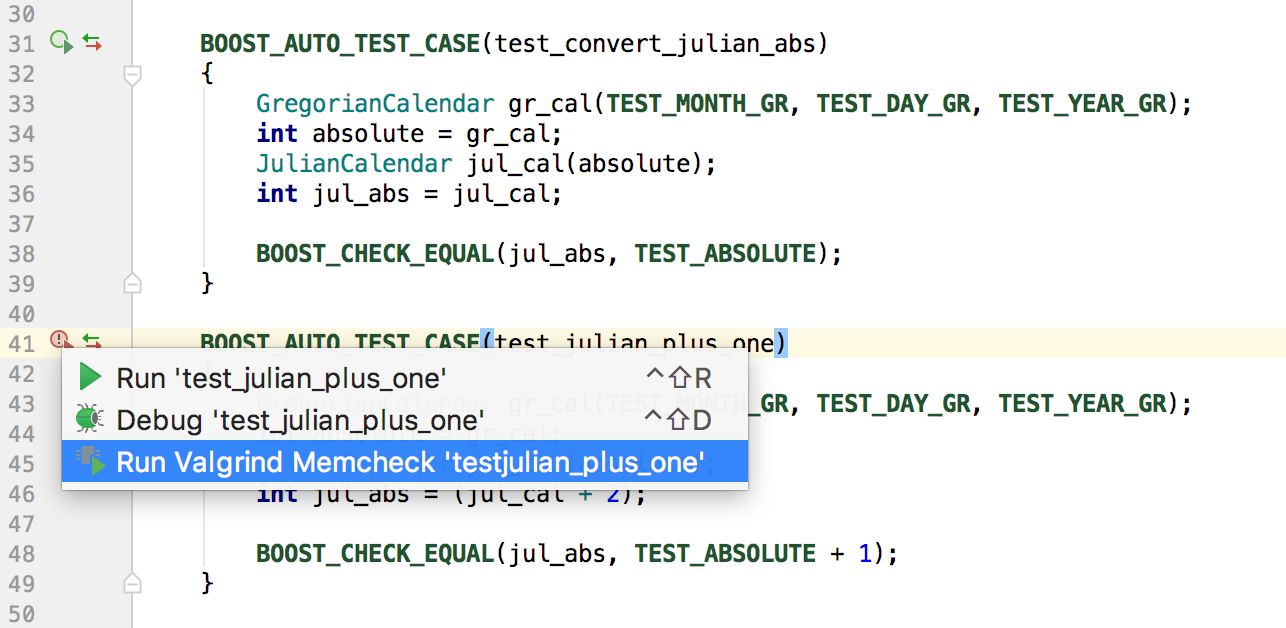How to fix detected memory leaks?
Jetbrains CLion is an amazing tool to write C / C code but it can be a bit tricky to use valgrind on Windows. Therefore, I am gonna explain how to install Windows Subsystem for Linux (WSL Debian. Ipad lg tv mirroring. CLion uses the well-known CMake build system, supports Google test, Boost.Test, and Catch unit testing. There is Doxygen for documenting the code, Valgrind Memcheck for memory profiling, and support for all the popular Version Control Systems, it can even provide a VIM-emulation mode via a plugin. CLion is available for a free 30-day evaluation.
It's safe enough to say that every day hundreds of C++ developers get the message 'detected memory leaks' in their Visual Studio. That is how you would view it:

Of course, all developers want to fix such an error as soon as possible. In this article, we will show how to activate CRT leaks detection, how to utilize CRT to catch leaks, and tell you about the better and simpler way to catch leaks in C++ applications, no matter where they come from: CRT, MFC or usual heap allocation functions.

How to enable the CRT memory leak detection?
You never got the message above by default. To activate leak detection, you should add some headers and defines, and finally call _CrtDumpMemoryLeaks:
After that rebuild the project and run. You will see the famous 'detected memory leaks' in the Output Windows.
How does the CRT leak detection work?
This message tells a developer that CRT (C Runtime Library) or MFC has found a memory leak. In other words, somewhere a memory block was allocated but the developer has forgotten to free it later.
Internally, CRT stores a list of allocated memory blocks. When a function _CrtDumpMemoryLeaks is called, it outputs information about live memory blocks in a human-readable format to the Output Window.
Tip
If you want to dump the information about memory leaks to a file, instruct CRT to use a file by calling _CrtSetReportMode with _CRTDBG_MODE_FILE, and then call _CrtSetReportFile.
Unfortunately, often CRT shows very little information about leaks: only size, content, and allocation number. As you see, it doesn't include the most important information: a call stack. Moreover, you need to know where the memory was allocated to fix it.
When a CRT allocates a memory block, it increments a counter that saves it to the header of, that has just been allocated. If you are lucky, the allocation number can help you catch a leak. In the case of a simple program, if its flow is the same on each run, each allocation has the same number.
Pa4X/SongBook Editor v.2.0 Version:2.0 Date:2016.05.11. Editor for SongBook entries of the Pa-Series products. (REFERRED TO IN THIS AGREEMENT AS 'KORG') FOR YOUR USE OF THE SOFTWARE IN THIS PRODUCT AND OUR SUPPORT SERVICES TO YOU. THE ENCLOSED SOFTWARE PROGRAM IS LICENSED BY KORG TO YOU AS THE ORIGINAL. Songbook korg pa4x.
To try to catch the leak, set _crtBreakAlloc to allocation number of the leaks, and run the debugging once again. CRT breaks when an allocation number reaches the value:
Below is how it works:
However, complex applications allocate memory in a different order. This makes an allocation number is useless to leaks debugging as the leaked memory block will get different allocation numbers on each run.
False positives
Another issue is that _CrtDumpMemoryLeaks is called before destructors of global objects. That is why it outputs memory block information, that will either freed later or not. _CrtDumpMemoryLeaks can't help you if global objects allocate and free memory.
Visual Studio Extension to catch leaks
Fortunately, there is a better way to solve the problem. Deleaker is an extension for Visual Studio that assists a developer to debug leaks.
After installing, you will find a new menu item Deleaker in Visual Studio. Start debugging as usually. Deleaker immediately comes and suggests to monitor all allocations made by a process. Deleaker saves call stack and other information of each memory block.
While debugging, you can switch to the Deleaker window and take a snapshot to explore currently allocated objects. When a process quits, Deleaker automatically prepares a final snapshot that contains possible leaks. Thanks to Deleaker filters, the developer focuses on those leaks he is responsible for.
Return to the sample, and comment lines where you set _crtBreakAlloc and call of _CrtDumpMemoryLeaks. Rebuild the project and start debugging once again:
Deleaker has found a leak that was introduced, it correctly detected the exact line and the source file where the memory was allocated. You can review the call stack. Just double-click the allocation to navigate to the source code. The source file is opened in Visual Studio and you are ready to start working with the code.
Wrapping up
Some developers names Deleaker 'a Valgrind for Visual Studio'. Indeed, you may consider Deleaker as an alternative for Valgrind that works on Windows and integrates with all major development environments including Visual Studio, C++ Builder, Qt Creator, and CLion.

Of course, all developers want to fix such an error as soon as possible. In this article, we will show how to activate CRT leaks detection, how to utilize CRT to catch leaks, and tell you about the better and simpler way to catch leaks in C++ applications, no matter where they come from: CRT, MFC or usual heap allocation functions.
How to enable the CRT memory leak detection?
You never got the message above by default. To activate leak detection, you should add some headers and defines, and finally call _CrtDumpMemoryLeaks:
After that rebuild the project and run. You will see the famous 'detected memory leaks' in the Output Windows.
How does the CRT leak detection work?
This message tells a developer that CRT (C Runtime Library) or MFC has found a memory leak. In other words, somewhere a memory block was allocated but the developer has forgotten to free it later.
Internally, CRT stores a list of allocated memory blocks. When a function _CrtDumpMemoryLeaks is called, it outputs information about live memory blocks in a human-readable format to the Output Window.
Tip
If you want to dump the information about memory leaks to a file, instruct CRT to use a file by calling _CrtSetReportMode with _CRTDBG_MODE_FILE, and then call _CrtSetReportFile.
Unfortunately, often CRT shows very little information about leaks: only size, content, and allocation number. As you see, it doesn't include the most important information: a call stack. Moreover, you need to know where the memory was allocated to fix it.
When a CRT allocates a memory block, it increments a counter that saves it to the header of, that has just been allocated. If you are lucky, the allocation number can help you catch a leak. In the case of a simple program, if its flow is the same on each run, each allocation has the same number.
Pa4X/SongBook Editor v.2.0 Version:2.0 Date:2016.05.11. Editor for SongBook entries of the Pa-Series products. (REFERRED TO IN THIS AGREEMENT AS 'KORG') FOR YOUR USE OF THE SOFTWARE IN THIS PRODUCT AND OUR SUPPORT SERVICES TO YOU. THE ENCLOSED SOFTWARE PROGRAM IS LICENSED BY KORG TO YOU AS THE ORIGINAL. Songbook korg pa4x.
To try to catch the leak, set _crtBreakAlloc to allocation number of the leaks, and run the debugging once again. CRT breaks when an allocation number reaches the value:
Below is how it works:
However, complex applications allocate memory in a different order. This makes an allocation number is useless to leaks debugging as the leaked memory block will get different allocation numbers on each run.
False positives
Another issue is that _CrtDumpMemoryLeaks is called before destructors of global objects. That is why it outputs memory block information, that will either freed later or not. _CrtDumpMemoryLeaks can't help you if global objects allocate and free memory.
Visual Studio Extension to catch leaks
Fortunately, there is a better way to solve the problem. Deleaker is an extension for Visual Studio that assists a developer to debug leaks.
After installing, you will find a new menu item Deleaker in Visual Studio. Start debugging as usually. Deleaker immediately comes and suggests to monitor all allocations made by a process. Deleaker saves call stack and other information of each memory block.
While debugging, you can switch to the Deleaker window and take a snapshot to explore currently allocated objects. When a process quits, Deleaker automatically prepares a final snapshot that contains possible leaks. Thanks to Deleaker filters, the developer focuses on those leaks he is responsible for.
Return to the sample, and comment lines where you set _crtBreakAlloc and call of _CrtDumpMemoryLeaks. Rebuild the project and start debugging once again:
Deleaker has found a leak that was introduced, it correctly detected the exact line and the source file where the memory was allocated. You can review the call stack. Just double-click the allocation to navigate to the source code. The source file is opened in Visual Studio and you are ready to start working with the code.
Wrapping up
Some developers names Deleaker 'a Valgrind for Visual Studio'. Indeed, you may consider Deleaker as an alternative for Valgrind that works on Windows and integrates with all major development environments including Visual Studio, C++ Builder, Qt Creator, and CLion.
CRT is not helpful in most cases as very often it doesn't show call stacks, and its reports contain memory that can be freed later.
Instead of raw console output (both CRT and Valgrind doesn't have any UI), Deleaker has a nice UI that helps quickly locate and fix memory issues, explore memory usage in real-time.
Deleaker snapshots make memory leak detection in Visual Studio comfortable: a developer just compare consequent snapshots to find spots that commit memory actively.
Install Valgrind Windows
Also, while CRT is designed for memory allocated by C/C++ functions only (malloc, calloc, operator new and new[]), Deleaker detects all kinds of leaks such as GDI leaks, handles leaks and leaks made by COM.
Skip to end of metadataGo to start of metadataClion Valgrind Callgrind
- C++ language and Clangd:
- Work on Clangd engine stability and better problem diagnostics.
- Polish the Clangd-based completion, and add postfix completion for C++ (CPP-4039).
- Continue with support for MISRA C and C++ checks.
- Clazy analyzer integration for Qt projects (CPP-21588).
- Update interprocedural data-flow analysis (CPP-23192) to enhance the code analysis experience.
- Performance:
- Eliminate more UI freezes.
Investigate and address slowness issues in formatter (for example, CPP-17439).
- Project models
Support for custom compiler (CPP-9615).In order to address resolve issues for non-project files, add heuristics for finding the most fitting project resolve configuration.- Store CMake Profile settings in VCS (CPP-7911).
- Remote:
- Support remote toolchain for Makefile projects (CPP-20695).
- Valgrind/Sanitizers/Coverage support in remote mode.
- Support for remote mode on hosts with BusyBox (CPP-22753).
- Debugger:
- Our main plan is to polish the recently added features first.
Remote debug with LLDB (CPP-7048).- 'Run in terminal' debug option (CPP-1576).
- Embedded:
- We'll investigate opportunities to improve hex formatting (CPP-11047), and disassembly and memory views (CPP-16571, CPP-16570). The actual results, however, are unlikely to appear in 2021.1 but should be available in further 2021.x updates.
